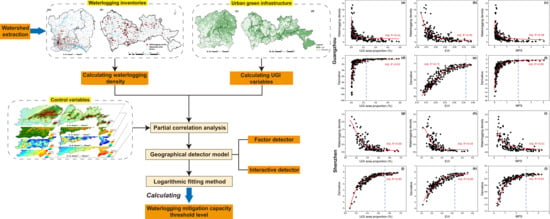Investigating the Role of Green Infrastructure on Urban WaterLogging: Evidence from Metropolitan Coastal Cities
Abstract
1. Introduction
2. Materials and Methods
2.1. Study Area and Data
2.1.1. Study Area
2.1.2. Dataset
2.2. Integrated Framework
2.3. Watershed Unit
2.4. Measuring Green Infrastructure Composition and Spatial Configuration
2.5. Control Variables
2.6. Statistical Analyses
2.6.1. UGI and Waterlogging Clusters Extraction
2.6.2. Partial Correlation Analysis
2.6.3. Geographical Detector Model
2.6.4. Thresholds Level of UGI Affecting Waterlogging
3. Results
3.1. Spatial Patterns of UGI and Urban Waterlogging
3.1.1. Spatial Pattern of UGI between Two Cities
3.1.2. Urban Waterlogging Spatial Agglomeration Effect between Two Cities
3.2. Impacts of UGI on Urban Waterlogging
3.2.1. Partial Correlations between UGI and Waterlogging
3.2.2. Individual and Interactive Effects of UGI Factors on Urban Waterlogging
3.3. Threshold Level of UGI Affecting Waterlogging
4. Discussion
4.1. Spatial Variations of Urban Waterlogging
4.2. The Mitigation Effect of UGI on Waterlogging
4.3. Threshold Level of Waterlogging Mitigation Effect
4.4. Limitations and Uncertainties
5. Conclusions
Author Contributions
Funding
Institutional Review Board Statement
Informed Consent Statement
Data Availability Statement
Acknowledgments
Conflicts of Interest
References
- Lin, J.; He, X.; Lu, S.; Liu, D.; He, P. Investigating the influence of three-dimensional building configuration on urban pluvial flooding using random forest algorithm. Environ. Res. 2020, 196, 110438. [Google Scholar] [CrossRef]
- Zhang, Q.; Wu, Z.; Guo, G.; Zhang, H.; Tarolli, P. Explicit the urban waterlogging spatial variation and its driving factors: The stepwise cluster analysis model and hierarchical partitioning analysis approach. Sci. Total Environ. 2020, 763, 143041. [Google Scholar] [CrossRef]
- Zhao, G.; Pang, B.; Xu, Z.; Peng, D.; Xu, L. Assessment of urban flood susceptibility using semi-supervised machine learning model. Sci. Total Environ. 2019, 659, 940–949. [Google Scholar] [CrossRef] [PubMed]
- United Nations. World Urbanization Prospects: The 2018 Revision. Available online: https://www.un.org/development/desa/pd/content/world-urbanization-prospects-2018-revision (accessed on 15 January 2021).
- Qiu, J.; Cao, B.; Park, E.; Yang, X.; Zhang, W.; Tarolli, P. Flood Monitoring in Rural Areas of the Pearl River Basin (China) Using Sentinel-1 SAR. Remote Sens. 2021, 13, 1384. [Google Scholar] [CrossRef]
- Liquete, C.; Kleeschulte, S.; Dige, G.; Maes, J.; Grizzetti, B.; Olah, B.; Zulian, G. Mapping green infrastructure based on ecosystem services and ecological networks: A Pan-European case study. Environ. Sci. Policy 2015, 54, 268–280. [Google Scholar] [CrossRef]
- Le, M.T.; Cao, T.A.T.; Tran, N.A.Q. The role of green space in the urbanization of Hanoi city. In E3S Web of Conferences; EDP Sciences: Ulis, France, 2019; Volume 97. [Google Scholar]
- Zhong, Y.D.; Jia, Y.W.; Li, Z.W. Spatial and temporal changes of maximum 1 h precipitation intensity in Beijing region in last 53 years. J. China Hydrol. 2013, 33, 32–37. [Google Scholar]
- Lyu, H.M.; Shen, S.L.; Zhou, A.N.; Zhou, W.H. Flood risk assessment of metro systems in a subsiding environment using the interval FAHP-FCA approach. Sustain. Cities Soc. 2019, 50, 101682. [Google Scholar] [CrossRef]
- Zhang, Q.; Wu, Z.; Zhang, H.; Dalla Fontana, G.; Tarolli, P. Identifying dominant factors of waterlogging events in metropolitan coastal cities: The case study of Guangzhou, China. J. Environ. Manag. 2020, 271, 110951. [Google Scholar] [CrossRef] [PubMed]
- Sofia, G.; Roder, G.; Dalla Fontana, G.; Tarolli, P. Flood dynamics in urbanised landscapes: 100 years of climate and humans’ interaction. Sci. Rep. 2017, 7, 1–12. [Google Scholar] [CrossRef]
- Huang, H.; Chen, X.; Zhu, Z.; Xie, Y.; Liu, L.; Wang, X.; Wang, X.; Liu, K. The changing pattern of urban flooding in Guangzhou, China. Sci. Total Environ. 2018, 622, 394–401. [Google Scholar] [CrossRef]
- Yang, H.; Dick, W.A.; McCoy, E.L.; Phelan, P.L.; Grewal, P.S. Field evaluation of a new biphasic rain garden for stormwater flow management and pollutant removal. Ecol. Eng. 2013, 54, 22–31. [Google Scholar] [CrossRef]
- Amado, L.; Albuquerque, A.; Santo, A.E. Influence of stormwater infiltration on the treatment capacity of a LECA-based horizontal subsurface flow constructed wetland. Ecol. Eng. 2012, 39, 16–23. [Google Scholar] [CrossRef]
- IPCC. Climate Change 2014: Impacts, Adaptation, and Vulnerability: Working Group II Contribution to the Fifth Assessment Report of the Intergovernmental Panel on Climate Change; Cambridge University Press: Cambridge, UK, 2014. [Google Scholar]
- Ministry of Water Resources of the People’s Republic of China. Available online: http://www.mwr.gov.cn (accessed on 22 January 2021).
- Tehrany, M.S.; Jones, S.; Shabani, F. Identifying the essential flood conditioning factors for flood prone area mapping using machine learning techniques. Catena 2019, 175, 174–192. [Google Scholar] [CrossRef]
- Wang, C.; Du, S.; Wen, J.; Zhang, M.; Gu, H.; Shi, Y.; Xu, H. Analyzing explanatory factors of urban pluvial floods in Shanghai using geographically weighted regression. Stochastic Environ. Res. Risk Assess. 2017, 31, 1777–1790. [Google Scholar] [CrossRef]
- Li, B.; Zhao, Y.; Fu, Y. Spatio-temporal characteristics of urban stormwaterlogging in Guangzhou and the impact of urban growth. Geo Inf. Sci. 2015, 17, 445–450. [Google Scholar]
- Zhang, H.; Wu, C.; Chen, W.; Huang, G. Assessing the impact of climate change on the waterlogging risk in coastal cities: A case study of Guangzhou, South China. J. Hydrometeorol. 2017, 18, 1549–1562. [Google Scholar] [CrossRef]
- Wu, J.; Sha, W.; Zhang, P.; Wang, Z. The spatial non-stationary effect of urban landscape pattern on urban waterlogging: A case study of Shenzhen City. Sci. Rep. 2020, 10, 1–15. [Google Scholar] [CrossRef]
- Huong, H.T.L.; Pathirana, A. Urbanization and climate change impacts on future urban flooding in Can Tho City, Vietnam. Hydrol. Earth Syst. Sci. 2013, 17, 379–394. [Google Scholar] [CrossRef]
- Wang, J.; Gao, W.; Xu, S.; Yu, L. Evaluation of the combined risk of sea level rise, land subsidence, and storm surges on the coastal areas of Shanghai, China. Clim. Chang. 2012, 115, 537–558. [Google Scholar] [CrossRef]
- Zhao, G.; Pang, B.; Xu, Z.; Yue, J.; Tu, T. Mapping flood susceptibility in mountainous areas on a national scale in China. Sci. Total Environ. 2018, 615, 1133–1142. [Google Scholar] [CrossRef]
- Wu, J.S.; Zhang, P.H. The effect of urban landscape pattern on urban waterlogging. Acta Geogr. Sin. 2017, 3, 26–36. [Google Scholar]
- Liu, F.; Liu, X.; Xu, T.; Yang, G.; Zhao, Y. Driving Factors and Risk Assessment of Rainstorm Waterlogging in Urban Agglomeration Areas: A Case Study of the Guangdong-Hong Kong-Macao Greater Bay Area, China. Water 2021, 13, 770. [Google Scholar] [CrossRef]
- Zhang, B.; Li, N.; Wang, S. Effect of urban green space changes on the role of rainwater runoff reduction in Beijing, China. Landsc. Urban Plan. 2015, 140, 8–16. [Google Scholar] [CrossRef]
- Zhang, B.; Xie, G.; Zhang, C.; Zhang, J. The economic benefits of rainwater-runoff reduction by urban green spaces: A case study in Beijing, China. J. Environ. Manag. 2012, 100, 65–71. [Google Scholar] [CrossRef]
- Dong, W.; Lian, Y.; Zhang, Y. Sustainable Development of Water Resources and Hydraulic Engineering in China Proceedings for the 2016 International Conference on Water Resource and Hydraulic Engineering; Springer: Cham, Switzerland, 2018. [Google Scholar]
- Pour, S.H.; Abd Wahab, A.K.; Shahid, S.; Dewan, A. Low impact development techniques to mitigate the impacts of climate-change-induced urban floods: Current trends, issues and challenges. Sustain. Cities Soc. 2020, 62, 102373. [Google Scholar] [CrossRef]
- Palliwoda, J.; Banzhaf, E.; Priess, J.A. How do the green components of urban green infrastructure influence the use of ecosystem services? Examples from Leipzig, Germany. Landsc. Ecol. 2020, 35, 1127–1142. [Google Scholar] [CrossRef]
- Yu, Z.; Fryd, O.; Sun, R.; Jørgensen, G.; Yang, G.; Özdil, N.C.; Vejre, H. Where and how to cool? An idealized urban thermal security pattern model. Landsc. Ecol. 2020, 1–10. [Google Scholar] [CrossRef]
- Amundsen, O.M.; Allen, W.; Hoellen, K. Green infrastructure planning: Recent advances and applications. In Planners Advisory Service Memo; American Planning Association: Chicago, IL, USA, 2009. [Google Scholar]
- Schuch, G.; Serrao-Neumann, S.; Morgan, E.; Choy, D.L. Water in the city: Green open spaces, land use planning and flood management–An Australian case study. Land Use Policy 2017, 63, 539–550. [Google Scholar] [CrossRef]
- Lovell, S.T.; Taylor, J.R. Supplying urban ecosystem services through multifunctional green infrastructure in the United States. Landsc. Ecol. 2013, 28, 1447–1463. [Google Scholar] [CrossRef]
- Du, S.; Wang, C.; Shen, J.; Wen, J.; Gao, J.; Wu, J.; Lin, W.; Xu, H. Mapping the capacity of concave green land in mitigating urban pluvial floods and its beneficiaries. Sustain. Cities Soc. 2019, 44, 774–782. [Google Scholar] [CrossRef]
- Guo, G.; Wu, Z.; Chen, Y. Complex mechanisms linking land surface temperature to greenspace spatial patterns: Evidence from four southeastern Chinese cities. Sci. Total Environ. 2019, 674, 77–87. [Google Scholar] [CrossRef]
- Guo, G.; Wu, Z.; Xiao, R.; Chen, Y.; Liu, X.; Zhang, X. Impacts of urban biophysical composition on land surface temperature in urban heat island clusters. Landsc. Urban Plan. 2015, 135, 1–10. [Google Scholar] [CrossRef]
- Pickett, S.T.; Cadenasso, M.L.; Grove, J.M.; Boone, C.G.; Groffman, P.M.; Irwin, E.; Warren, P. Urban ecological systems: Scientific foundations and a decade of progress. J. Environ. Manag. 2011, 92, 331–362. [Google Scholar] [CrossRef]
- Luan, X.; Yu, Z.; Zhang, Y.; Wei, S.; Miao, X.; Huang, Z.Y.X.; Teng, S.N.; Xu, C. Remote sensing and social sensing data reveal scale-dependent and system-specific strengths of urban heat island determinants. Remote Sens. 2020, 12, 391. [Google Scholar] [CrossRef]
- Kim, H.W.; Park, Y. Urban green infrastructure and local flooding: The impact of landscape patterns on peak runoff in four Texas MSAs. Appl. Geogr. 2016, 77, 72–81. [Google Scholar] [CrossRef]
- Yao, L.; Chen, L.; Wei, W.; Sun, R. Potential reduction in urban runoff by green spaces in Beijing: A scenario analysis. Urban For. Urban Green. 2015, 14, 300–308. [Google Scholar] [CrossRef]
- Yang, L.; Zhang, L.; Li, Y.; Wu, S. Water-related ecosystem services provided by urban green space: A case study in Yixing City (China). Landsc. Urban Plan. 2015, 136, 40–51. [Google Scholar] [CrossRef]
- Yang, X.; You, X.Y.; Ji, M.; Nima, C. Influence factors and prediction of stormwater runoff of urban green space in Tianjin, China: Laboratory experiment and quantitative theory model. Water Sci. Technol. 2013, 67, 869–876. [Google Scholar] [CrossRef]
- Liu, W.; Chen, W.; Peng, C. Assessing the effectiveness of green infrastructures on urban flooding reduction: A community scale study. Ecol. Model. 2014, 291, 6–14. [Google Scholar] [CrossRef]
- Roy, S.; Byrne, J.; Pickering, C. A systematic quantitative review of urban tree benefits, costs, and assessment methods across cities in different climatic zones. Urban For. Urban Green. 2012, 11, 351–363. [Google Scholar] [CrossRef]
- Silva, M.M.; Costa, J.P. Urban floods and climate change adaptation: The potential of public space design when accommodating natural processes. Water 2018, 10, 180. [Google Scholar] [CrossRef]
- Armson, D.; Stringer, P.; Ennos, A.R. The effect of street trees and amenity grass on urban surface water runoff in Manchester, UK. Urban For. Urban Green. 2013, 12, 282–286. [Google Scholar] [CrossRef]
- Richards, P.J.; Farrell, C.; Tom, M.; Williams, N.S.G.; Fletcher, T.D. Vegetable rain gardens can produce food and reduce stormwater runoff. Urban For. Urban Green. 2015, 14, 646–654. [Google Scholar] [CrossRef]
- Wen, L.; Weiping, C.; Chi, P. Modeling the effects of green infrastructure on storm water runoff reduction on community scale. Acta Ecol. Sin. 2016, 36, 1686–1697. [Google Scholar]
- Du, S.; He, C.; Huang, Q.; Shi, P. How did the urban land in floodplains distribute and expand in China from 1992–2015? Environ. Res. Lett. 2018, 13, 034018. [Google Scholar] [CrossRef]
- Pijl, A.; Brauer, C.C.; Sofia, G.; Teuling, A.J.; Tarolli, P. Hydrologic impacts of changing land use and climate in the Veneto lowlands of Italy. Anthropocene 2018, 22, 20–30. [Google Scholar] [CrossRef]
- Guangzhou Meteorological Service. Available online: http://www.tqyb.com.cn (accessed on 22 February 2021).
- Shenzhen Meteorological Bureau. Available online: http://weather.sz.gov.cn (accessed on 22 February 2021).
- Yu, H.; Zhao, Y.; Fu, Y.; Li, L. Spatiotemporal variance assessment of urban rainstorm waterlogging affected by impervious surface expansion: A case study of Guangzhou, China. Sustainability 2018, 10, 3761. [Google Scholar] [CrossRef]
- Xue, F.; Huang, M.; Wang, W.; Zou, L. Numerical Simulation of Urban Waterlogging Based on FloodArea Model. Adv. Meteorol. 2016, 2016, 1–9. [Google Scholar] [CrossRef]
- Zhang, S.L.; Gan, J.Y.; Zeng, Q.L.; Lu, G.N. Automatic compartmentalization of urban rainwater catchments on water outlet supported by GIS technology. J. Hydraul. Eng. 2007, 38, 325–329. [Google Scholar]
- Zuo, D.; Xu, Z.; Yao, W.; Jin, S.; Xiao, P.; Ran, D. Assessing the effects of changes in land use and climate on runoff and sediment yields from a watershed in the Loess Plateau of China. Sci. Total Environ. 2016, 544, 238–250. [Google Scholar] [CrossRef]
- McGarigal, K. FRAGSTATS: Spatial Pattern Analysis Program for Quantifying Landscape Structure; US Department of Agriculture, Forest Service, Pacific Northwest Research Station: Corvallis, OR, USA, 1995; Volume 351.
- Turner, M.G.; Gardner, R.H.; O’Neill, R.V. Landscape Ecology in Theory and Practice; Springer: New York, NY, USA, 2001; Volume 401. [Google Scholar]
- Cushman, S.A.; McGarigal, K.; Neel, M.C. Parsimony in landscape metrics: Strength, universality, and consistency. Ecol. Indic. 2008, 8, 691–703. [Google Scholar] [CrossRef]
- Yang, Z.; Sliuzas, R.; Cai, J.; Ottens, H.F. Exploring spatial evolution of economic clusters: A case study of Beijing. Int. J. Appl. Earth Obs. Geoinf. 2012, 19, 252–265. [Google Scholar] [CrossRef]
- Wang, J.F.; Li, X.H.; Christakos, G.; Liao, Y.L.; Zhang, T.; Gu, X.; Zheng, X.Y. Geographical detectors-based health risk assessment and its application in the neural tube defects study of the Heshun Region, China. Int. J. Geogr. Inf. Sci. 2010, 24, 107–127. [Google Scholar] [CrossRef]
- Zhang, L.; Liu, W.; Hou, K.; Lin, J.; Song, C.; Zhou, C.; Huang, B.; Tong, X.; Wang, J.; Rhine, W.; et al. Air pollution exposure associates with increased risk of neonatal jaundice. Nat. Commun. 2019, 10, 1–9. [Google Scholar] [CrossRef] [PubMed]
- Yin, Q.; Wang, J.; Ren, Z.; Li, J.; Guo, Y. Mapping the increased minimum mortality temperatures in the context of global climate change. Nat. Commun. 2019, 10, 1–8. [Google Scholar] [CrossRef] [PubMed]
- Wang, J.F.; Zhang, T.L.; Fu, B.J. A measure of spatial stratified heterogeneity. Ecol. Indic. 2016, 67, 250–256. [Google Scholar] [CrossRef]
- R Core Team. R: A Language and Environment for Statistical Computing. R Foundation for Statistical Computing, Vienna, Austria. Available online: http://www.R-project.org/ (accessed on 2 May 2021).
- Sofia, G.; Prosdocimi, M.; Dalla Fontana, G.; Tarolli, P. Modification of artificial drainage networks during the past half-century: Evidence and effects in a reclamation area in the Veneto floodplain (Italy). Anthropocene 2014, 6, 48–62. [Google Scholar] [CrossRef]
- Hansen, R.; Pauleit, S. From multifunctionality to multiple ecosystem services? A conceptual framework for multifunctionality in green infrastructure planning for urban areas. Ambio 2014, 43, 516–529. [Google Scholar] [CrossRef]
- Szota, C.; Coutts, A.M.; Thom, J.K.; Virahsawmy, H.K.; Fletcher, T.D.; Livesley, S.J. Street tree stormwater control measures can reduce runoff but may not benefit established trees. Landsc. Urban Plan. 2019, 182, 144–155. [Google Scholar] [CrossRef]
- Zhang, H.; Cheng, J.; Wu, Z.; Li, C.; Qin, J.; Liu, T. Effects of impervious surface on the spatial distribution of urban waterlogging risk spots at multiple scales in Guangzhou, South China. Sustainability 2018, 10, 1589. [Google Scholar] [CrossRef]
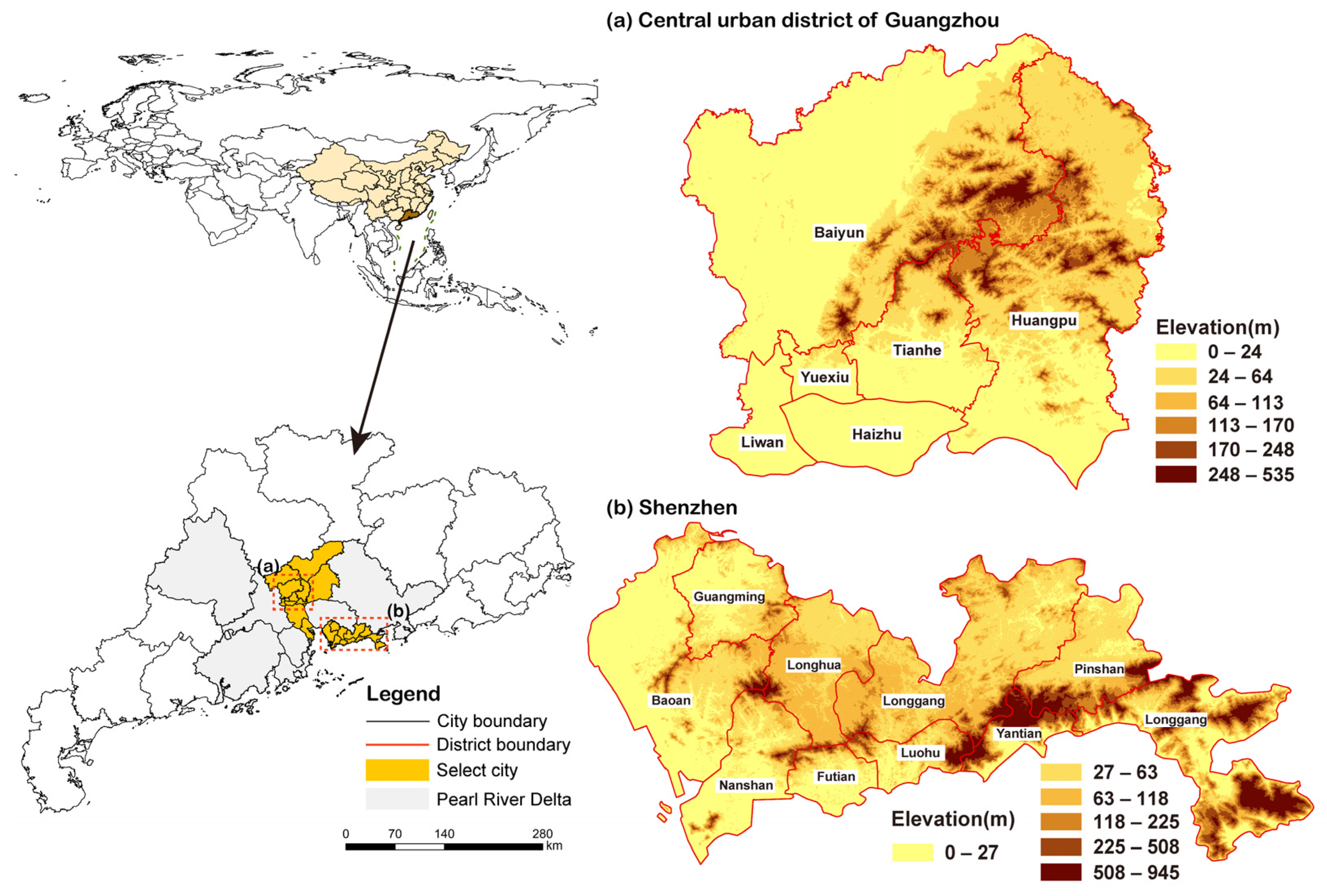
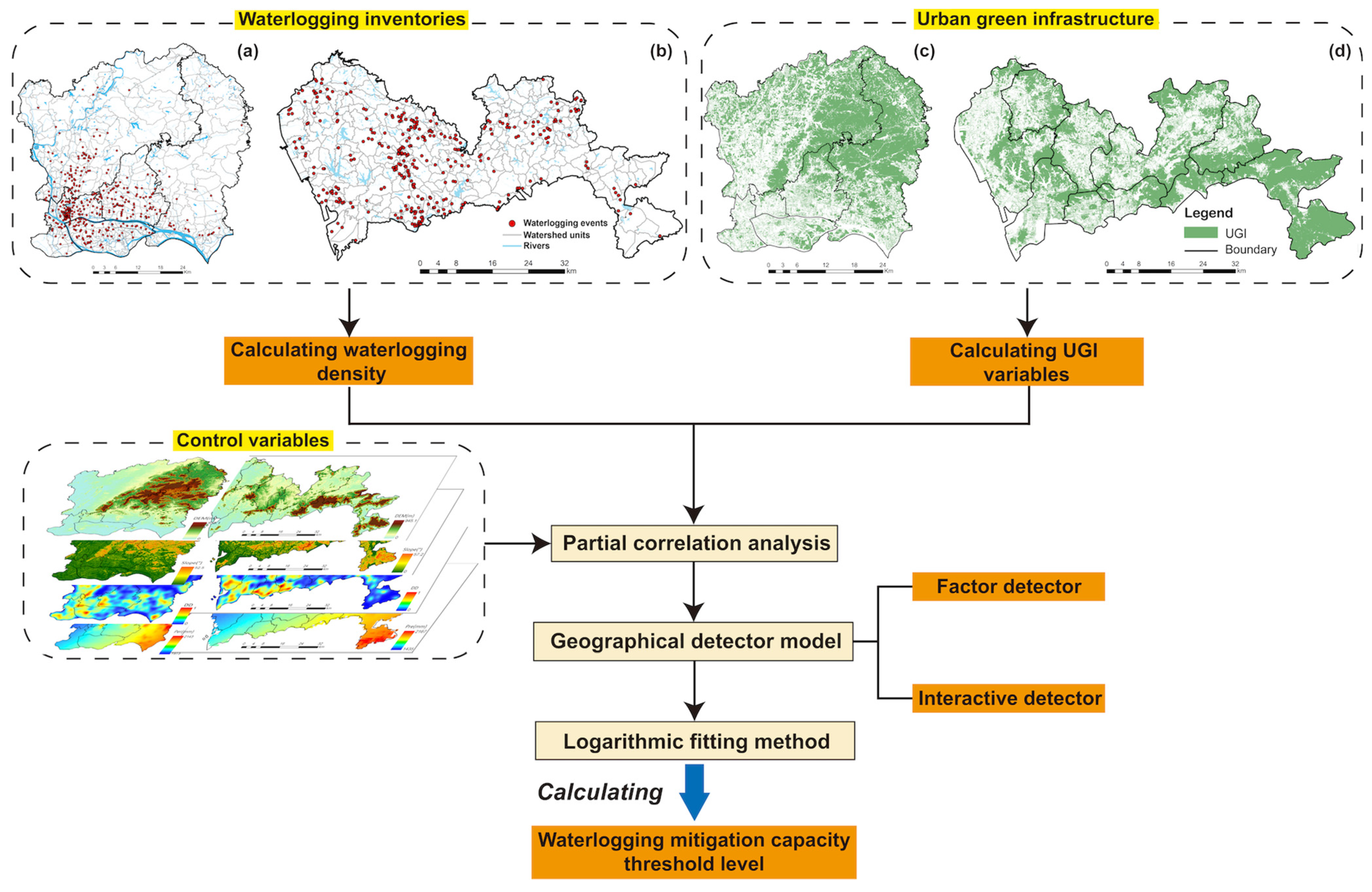

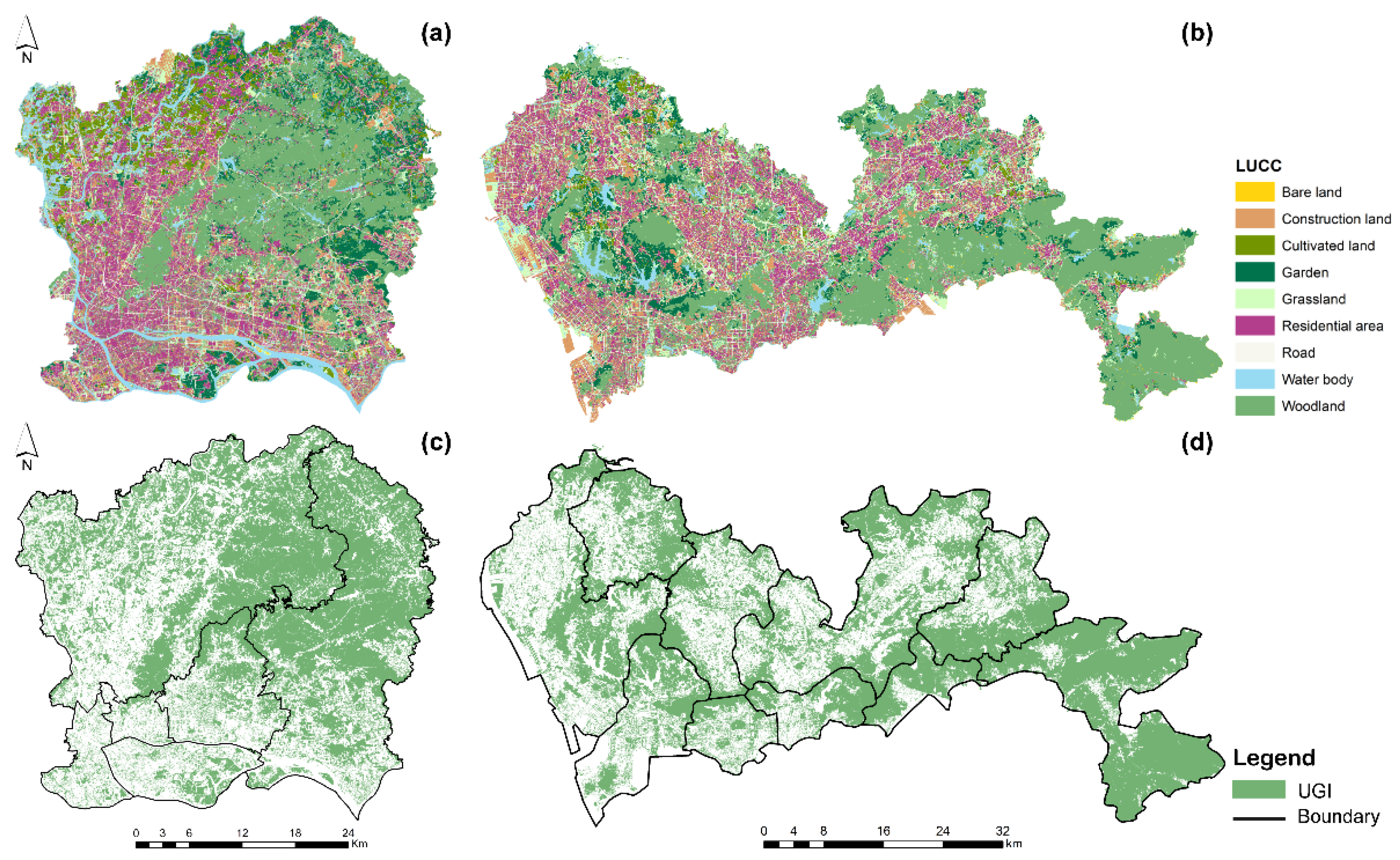
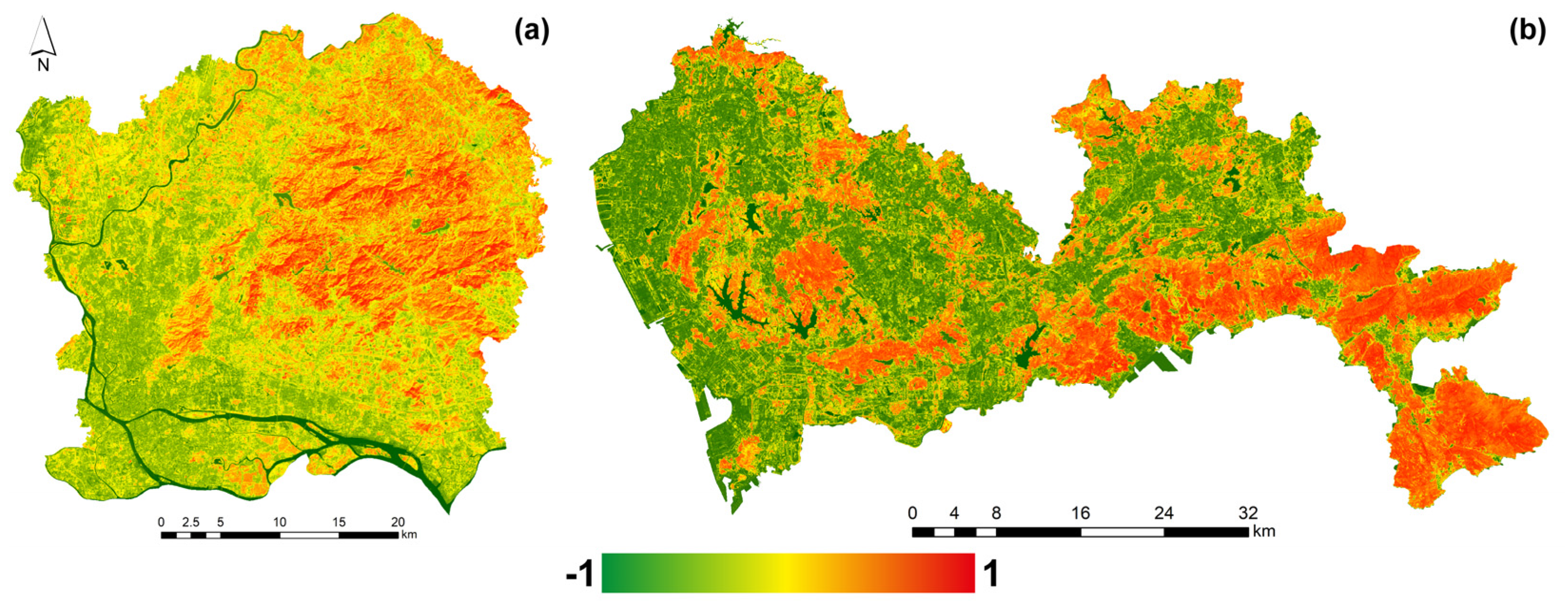
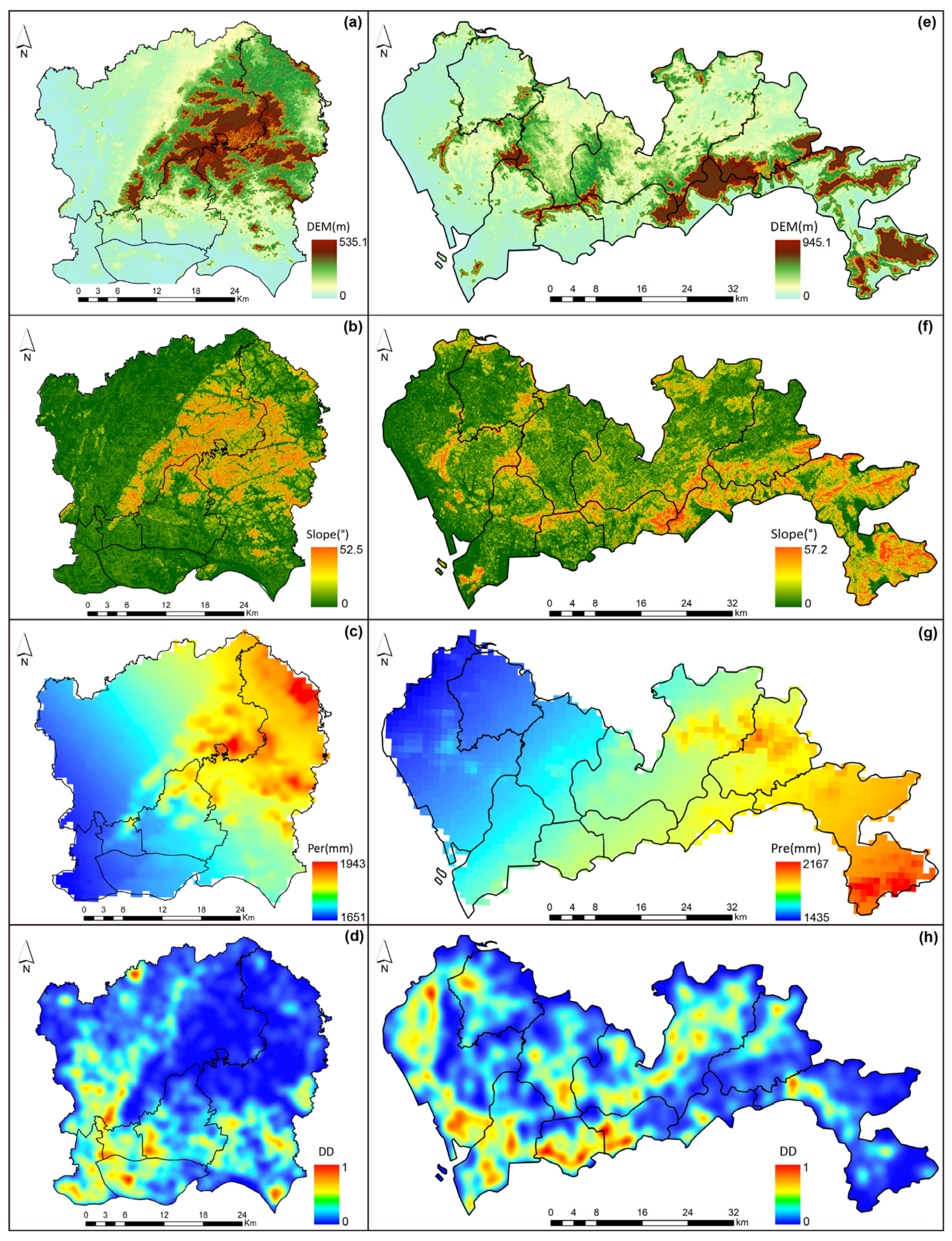
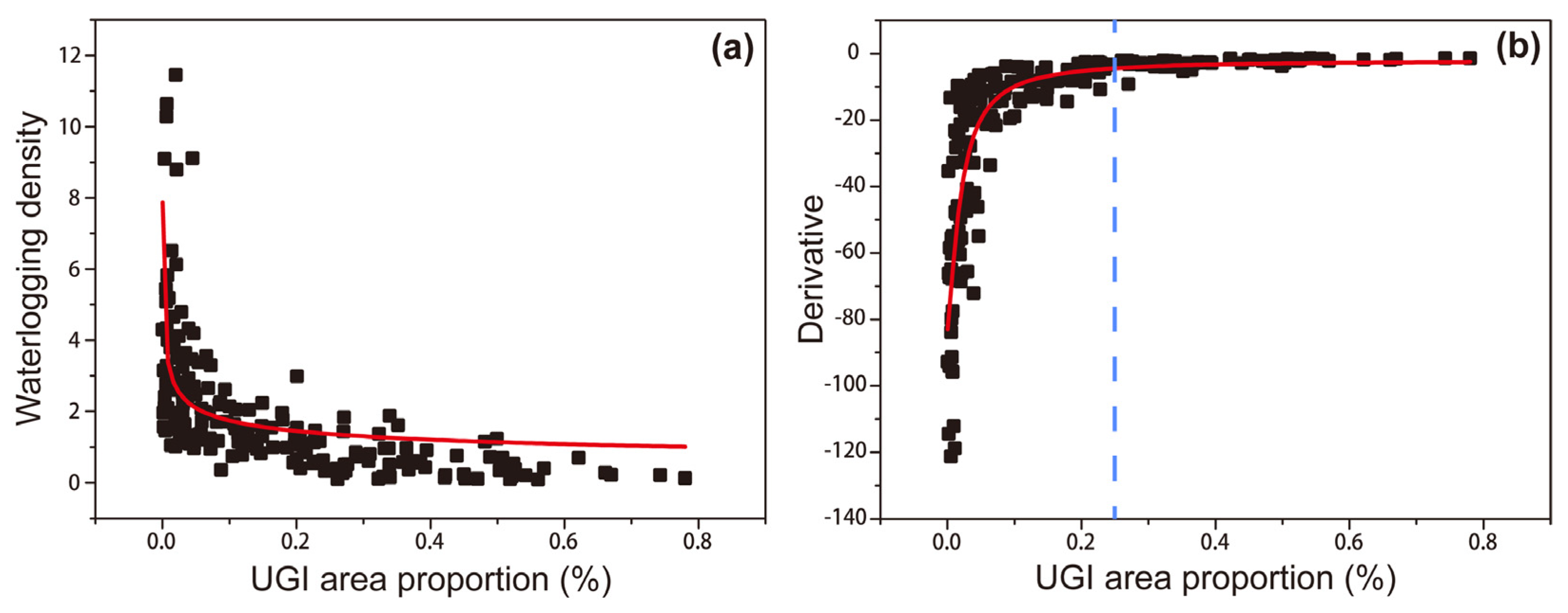
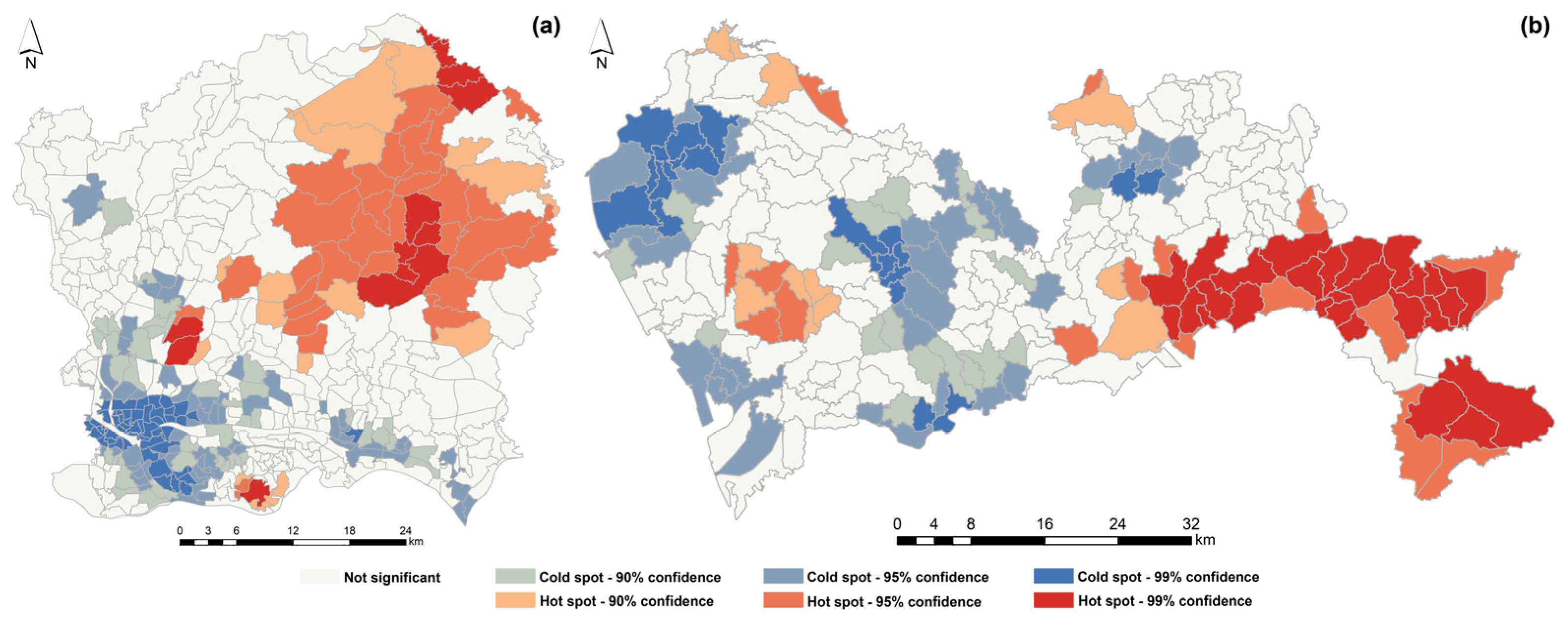
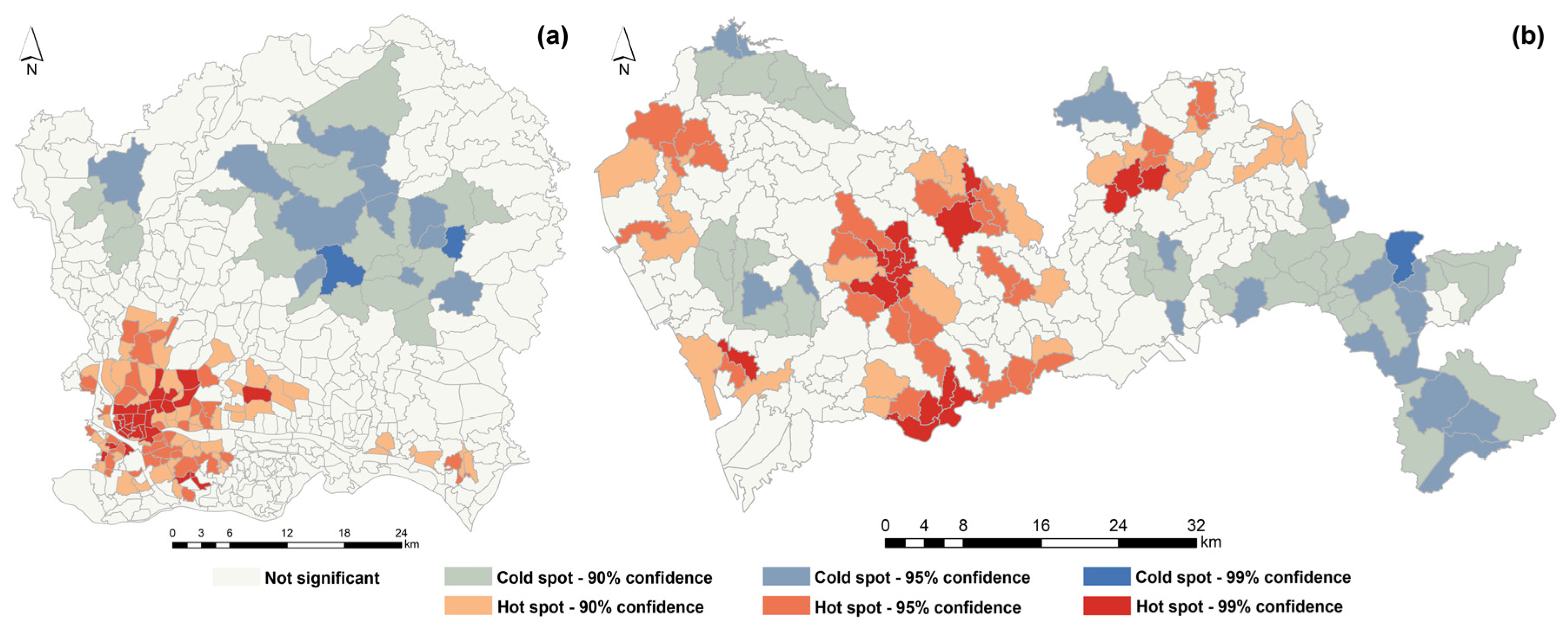
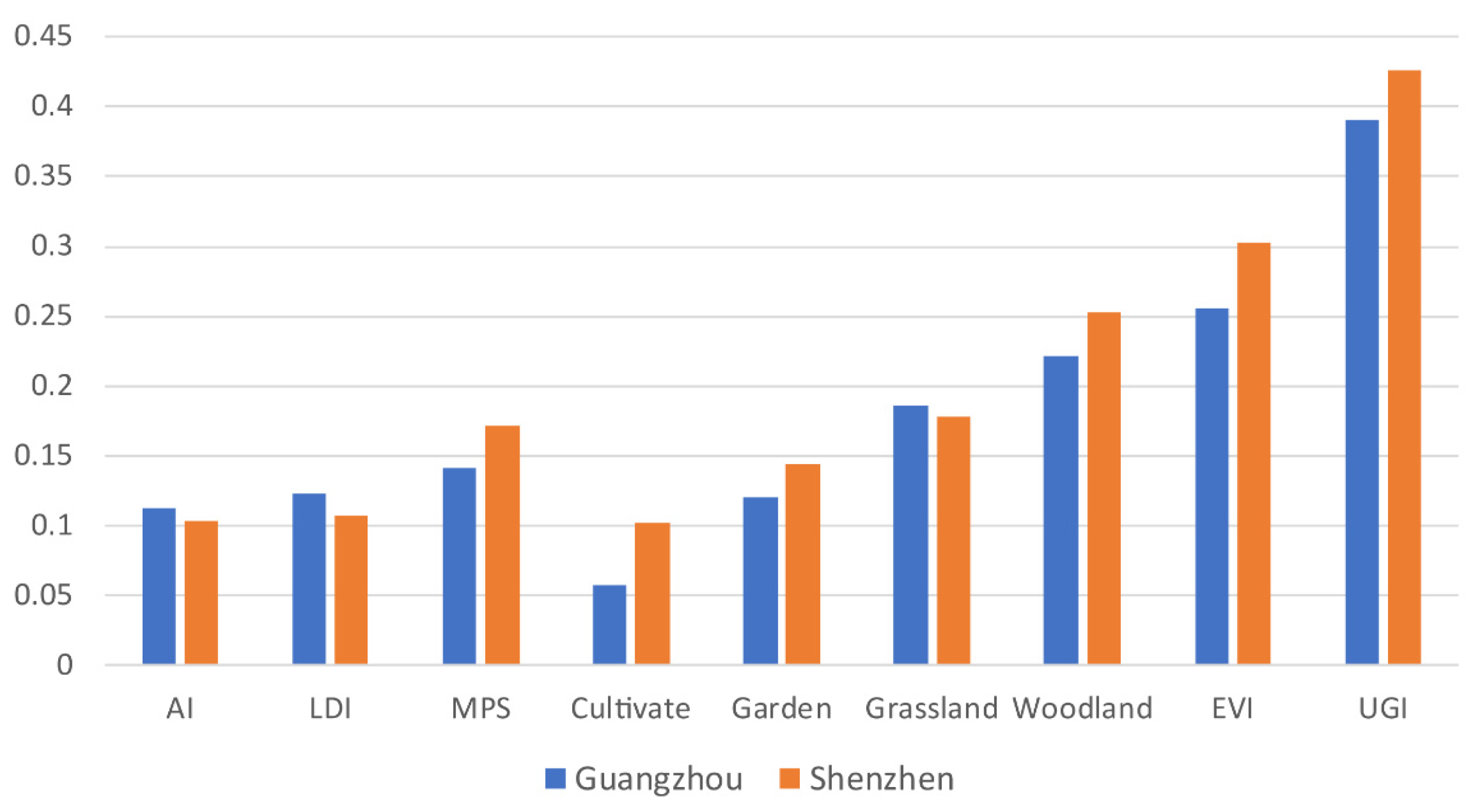
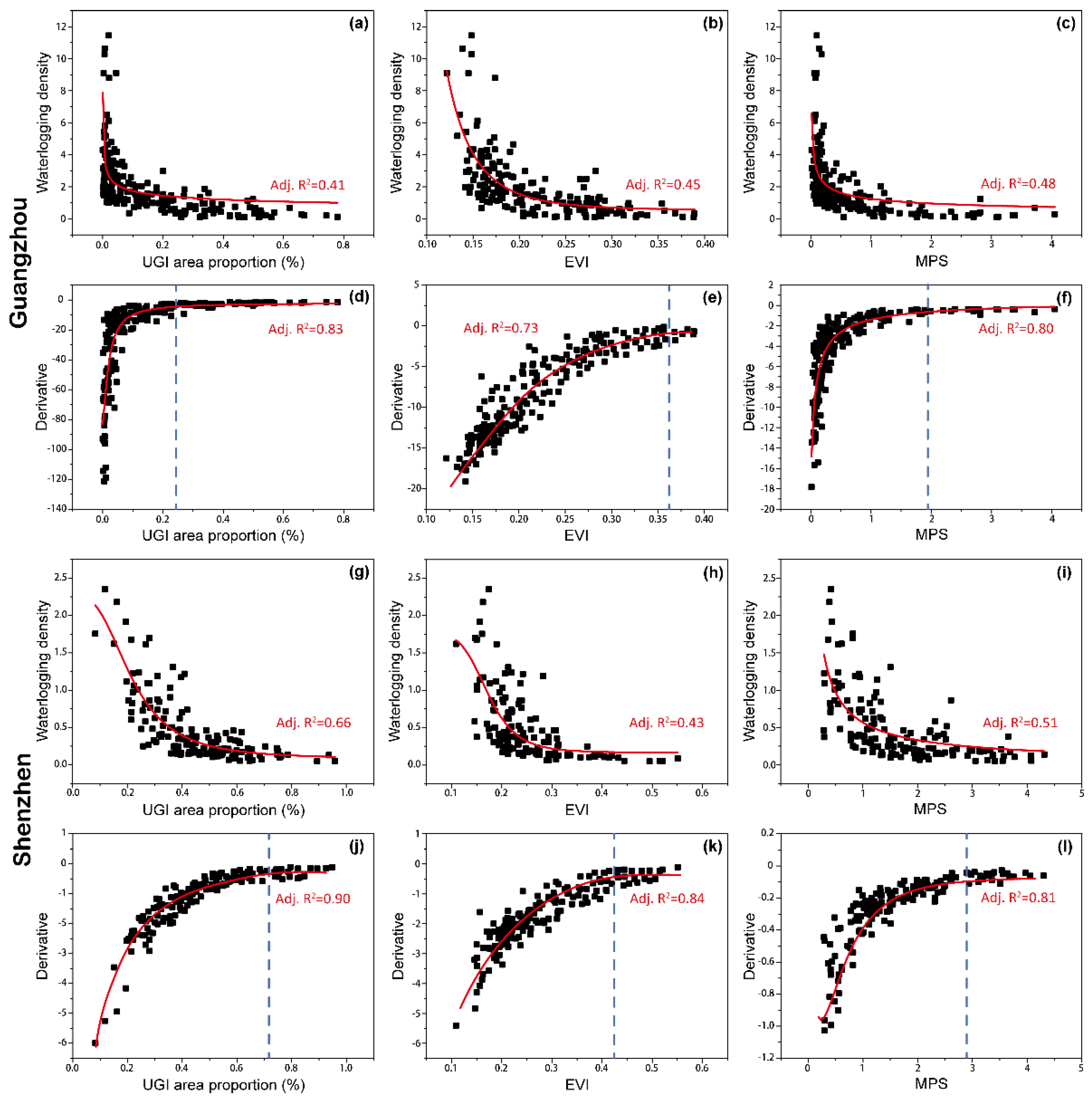
| Data | Format | Time | Detail | Source |
|---|---|---|---|---|
| Waterlogging locations | Shapefile | 2009–2015 | Point | Guangzhou Water Resources Bureau Shenzhen Water Resources Bureau |
| Landsat-8 OLI imagery | GeoTIFF | 2013 | 30 m (122-44, 121-44) | The USGS-EarthExplorer |
| UAV images | Raster | 2012 | 0.5 m | Land Resources Technology Center of Guangdong Province Shenzhen Planning and Natural Resources Bureau |
| Digital Elevation Model | Raster | 2012 | 5 m (accuracy 0.1 m) | |
| Drainage network | Shapefile | 2012 | Line | |
| River network | Shapefile | 2012 | Line | |
| Precipitation | Raster | 2009–2015 | 1 km | Geographical Information Monitoring Cloud Platform |
| Landscape Metrics | Equation * | Description |
|---|---|---|
| MPS | Reflects the average patch size of UGI. | |
| LDI | Reflects the degree of fragmentation of green infrastructure. | |
| AI | Measures the spatial distribution pattern of green infrastructure. |
| Interaction | Description |
|---|---|
| Nonlinear weaken | PD (A ∩ B) < Min[PD (A), PD (B)] |
| Unitary weaken | Min[PD (A), PD (B)] < PD (A ∩ B) < Max[PD (A), PD (B)] |
| Binary enhancement | PD (A ∩ B) > Max[PD (A), PD (B)] |
| Independent | PD (A ∩ B) = PD (A) + PD (B) |
| Nonlinear enhancement | PD (A ∩ B) > PD (A) + PD (B) |
| Composition | City | |||||||
|---|---|---|---|---|---|---|---|---|
| Guangzhou | Shenzhen | |||||||
| Woodland | 21.41% | 27.78% | ||||||
| Grassland | 4.73% | 7.82% | ||||||
| Cultivated land | 2.26% | 2.75% | ||||||
| Garden | 5.52% | 7.51% | ||||||
| Spatial configuration | Range | Mean | Median | S.D. | Range | Mean | Median | S.D. |
| MPS | 0.01–3.72 | 0.77 | 0.34 | 1.4 | 0.29–4.32 | 1.52 | 1.21 | 0.95 |
| LDI | 0.04–0.87 | 0.51 | 0.59 | 0.23 | 0.006–0.63 | 0.21 | 0.17 | 0.15 |
| AI | 67.94–99.53 | 91.47 | 88.52 | 2.81 | 65.17–97.98 | 95.77 | 94.33 | 4.26 |
| City | Area Percentage (%) | General G | Z-Score | p-Value | |
|---|---|---|---|---|---|
| Hot Spots | Cold Spots | ||||
| Guangzhou | 17.35 | 22.19 | 0.00008 | 18.33 | 0.00 |
| Shenzhen | 23.68 | 29.52 | 0.00002 | 12.94 | 0.00 |
| UGI Factors | City | Guangzhou | Shenzhen |
|---|---|---|---|
| Composition | EVI | −0.338 ** | −0.445 ** |
| UGI | −0.471 ** | −0.617 ** | |
| Woodland | −0.428 ** | −0.536 ** | |
| Grassland | −0.344 ** | −0.468 ** | |
| Garden | −0.232 ** | −0.359 ** | |
| Cultivate land | −0.131 | −0.238 * | |
| Spatial configuration | MPS | −0.351 ** | −0.502 ** |
| LDI | 0.337 ** | 0.407 ** | |
| AI | −0.278 | −0.354 ** |
| Guangzhou City | Shenzhen City | ||||
|---|---|---|---|---|---|
| Factor | Interactive PD | Enhancement | Factor | Interactive PD | Enhancement |
| PD (UGI ∩ EVI) | 0.525 | Binary | PD (UGI ∩ EVI) | 0.557 | Binary |
| PD (UGI ∩ MPS) | 0.446 | Binary | PD (UGI ∩ MPS) | 0.483 | Binary |
| PD (UGI ∩ LDI) | 0.424 | Binary | PD (UGI ∩ LDI) | 0.442 | Binary |
| PD (UGI ∩ AI) | 0.405 | Binary | PD (UGI ∩ AI) | 0.439 | Binary |
| PD (EVI ∩ MPS) | 0.474 | Nonlinear | PD (EVI ∩ MPS) | 0.505 | Nonlinear |
| PD (EVI ∩ LDI) | 0.362 | Binary | PD (EVI ∩ LDI) | 0.407 | Binary |
| PD (EVI ∩ AI) | 0.311 | Binary | PD (EVI ∩ AI) | 0.374 | Binary |
| PD (MPS ∩ LDI) | 0.252 | Binary | PD (MPS ∩ LDI) | 0.308 | Nonlinear |
| PD (MPS ∩ AI) | 0.267 | Nonlinear | PD (MPS ∩ AI) | 0.289 | Nonlinear |
| PD (LDI ∩ AI) | 0.238 | Nonlinear | PD (LDI ∩ AI) | 0.231 | Nonlinear |
Publisher’s Note: MDPI stays neutral with regard to jurisdictional claims in published maps and institutional affiliations. |
© 2021 by the authors. Licensee MDPI, Basel, Switzerland. This article is an open access article distributed under the terms and conditions of the Creative Commons Attribution (CC BY) license (https://creativecommons.org/licenses/by/4.0/).
Share and Cite
Zhang, Q.; Wu, Z.; Tarolli, P. Investigating the Role of Green Infrastructure on Urban WaterLogging: Evidence from Metropolitan Coastal Cities. Remote Sens. 2021, 13, 2341. https://doi.org/10.3390/rs13122341
Zhang Q, Wu Z, Tarolli P. Investigating the Role of Green Infrastructure on Urban WaterLogging: Evidence from Metropolitan Coastal Cities. Remote Sensing. 2021; 13(12):2341. https://doi.org/10.3390/rs13122341
Chicago/Turabian StyleZhang, Qifei, Zhifeng Wu, and Paolo Tarolli. 2021. "Investigating the Role of Green Infrastructure on Urban WaterLogging: Evidence from Metropolitan Coastal Cities" Remote Sensing 13, no. 12: 2341. https://doi.org/10.3390/rs13122341
APA StyleZhang, Q., Wu, Z., & Tarolli, P. (2021). Investigating the Role of Green Infrastructure on Urban WaterLogging: Evidence from Metropolitan Coastal Cities. Remote Sensing, 13(12), 2341. https://doi.org/10.3390/rs13122341







